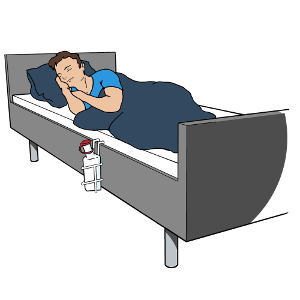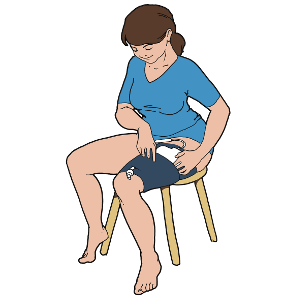Urine Collectors
Last updated 22-05-2025 If you experience issues with your bladder, incontinence, or find it problematic to use a toilet, especially during outings or travels, you may benefit from assistive products designed for urine collection. This guide provides information on various types of urine collectors.
If you experience issues with your bladder, incontinence, or find it problematic to use a toilet, especially during outings or travels, you may benefit from assistive products designed for urine collection. This guide provides information on various types of urine collectors.In AssistData, specifically under Assistive products for collecting urine and faeces, you can explore urine collection bags, urine bottles, and attachment devices, such as holders, racks, and pouches.
A diaper may also be part of the solution if you struggle with retaining urine and/or faeces.
For more information on adult diapers, please refer to the guide Diapers for Adults.
Will this be relevant for you?
Will this be relevant for you?
If you experience issues with your bladder, incontinence, or if you have a disability that makes it challenging to use a toilet, for instance during travels, meetings, and sports events, an assistive product for urine collection may be relevant for you.
A well-functioning assistive product can significantly enhance your quality of life in daily activities.
You may consider consulting your doctor, a continence nurse, or an assistive product therapist in your municipality for professional guidance in choosing the right assistive product.
What is available?
What is available?
There are different types of urine collectors, and it may be relevant to consider the following:
- Do you want the urine collector to be wearable on your body?
- Do you want to it be attachable, for instance to a wheelchair or a bed?
- Do you want it to be portable, or will it be intended only for home use?
When searching for a product for urine collection in AssistData, you can filter based on features relevant to you, such as whether they have a backflow valve, are for single use, etc.
Urine collection bags
Urine collection bags are used for the collection of urine through a catheter, a penile sheath, or a urostomy pouch. These bags come in two main types: those that can be suspended, for instance, on the edge of a bed (long tubes), and those worn on the leg (short tubes). They are available in various sizes with either a closed-end or open-end.
The most commonly used are open-ended urine collection bags, allowing urine to be emptied as needed without handling the area around the catheter. 
The bag has a valve for drainage, enabling you to empty the contents into, e.g. a toilet by opening the valve.
It is important to notice the recommended frequency for changing your urine bag. Many bags can be used for several days before replacement, reducing the number of times you have to handle the catheter. This can be an advantage as the risk of infection increases with the number of bag changes.
In some situations, a closed-ended urine collection bag may be preferred. This could be if catheterization is necessary in a location without access to a toilet. In such instances, you can empty the collected urine into a disposable bag and dispose of it appropriately.
You should consider the required capacity of the urine collection bag and whether it should be divided into multiple chambers. Bags with multiple chambers tend to bulge less under your clothing and produce less splashing.
Fastening of urine collection bags
Urine collection bags can be fastened in various ways. For individuals who are up and about, the bag is often attached to the thigh (for those walking) or to the calf (for those sitting) using a bag holder or fixation strap.
For individuals lying in bed, the urine collection bag can hang on the side of the bed, either using safety pins attached to the sheet or mattress or with a rack that can hang on the bed frame.
You can find examples of suspenders and fastening devices for urine collector in AssistData.
Non-body-worn urine bottles and urine collection bags
Non-body-worn urine bottles and urine collection bags are specifically designed for men, women, or in a unisex shape. Some are reusable, while others are designed for single use.
Single-use urine collection bags may contain absorbent granules, making them convenient for travel as they can be disposed of in regular trash bins.
In AssistData, you can also find containers for urine bottles, allowing you to keep your urine bottle within reach, for example, on the bedside.
Bedpans
A bedpan can collect both urine and faeces. Bedpans may be designed for use while standing, sitting, or lying down. The size of the bedpan may vary, and it is important to ensure that you can sit or lie on it stably and comfortably.
If the bedpan is to be used while lying or sitting, it should not be higher than what allows you to lift yourself onto it.
Bedpans are available in both metal and plastic. There are also specially soft disposable bedpans, such as inflatable bedpans, suitable for persons at risk of developing pressure sores and, therefore, unable to use a bedpan with hard edges.
You can also find disposable bedpans that are portable, convenient for travel purposes.
Many bedpans come with a lid, allowing you to cover the contents after use.
Cleaning and handling
Cleaning and handling
When using and handling urine bottles and bedpans, there is a risk of bacteria being spread. These assistive products should therefore be considered personal items.
You should always follow the manufacturers instructions regarding cleaning, maintenance, and disposal.
Safety during use
Safety during use
It is crucial to respond to any pain or discomfort associated with the use of an assistive product for urine collection. The assistive product should not cause e.g. chafing or skin irritation.
When using a catheter, there is an increased risk of developing cystitis if you can’t empty the bladder adequately. In case of cystitis, it is essential to drink plenty of fluids throughout the day to flush the urinary tract thoroughly. Consult your doctor regarding what to be aware of and any preventive measures you can take.
There is also a risk of infection every time you change your catheter or urine collection bag. Therefore, it is important to strictly follow the hygiene instructions from your nurse and not change more frequently than necessary.
When placing your urine collection bag, it is important that the bag be placed in a position that does not pull on the catheter. To ensure proper urine flow, it is also important to be aware of avoiding kinks in the tubing.
The bag should always be positioned below the level of the bladder. This means on the thigh or the calf when you are upright and on the bedside when lying down. The urine bag should not be placed on the floor, as this increases the risk of infection.
According to the guidelines from the Statens Serum Institut, a urine collection bag should be emptied when it is ¾ full to avoid stagnation in the tubing and backflow of urine.
For urine collection bags, there is a specific standard that includes requirements related to e.g. load, strength, and resistance to impacts:
DS/EN ISO 8669-2:1997 Urine collection bags. Part 2: Requirements and test methods
If you wish to learn more 
If you wish to learn more 
You can find more information about incontinence at Kontinensforeningen, a private patient organization that represents the interests of children and adults with urinary and faecal incontinence.
You can also read about urinary incontinence on the website of the Danish Health Authority - Inkontinens.
Additionally, see the Statens Serum Instituts national guideline on infection hygiene Prevention of urinary tract infection in connection with urinary drainage and incontinence aids, 2nd edition 2024



